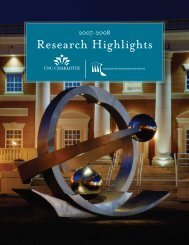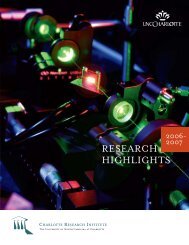rESEArCH HIGHLIGHTS - Charlotte Research Institute - University ...
rESEArCH HIGHLIGHTS - Charlotte Research Institute - University ...
rESEArCH HIGHLIGHTS - Charlotte Research Institute - University ...
Create successful ePaper yourself
Turn your PDF publications into a flip-book with our unique Google optimized e-Paper software.
Building a Translational <strong>Research</strong> Programconverting research into higher standards of careA new interdisciplinary focus for 2006-2007 is translational research. Plans are underway for the developmentof a Center for Translational <strong>Research</strong> that will leverage the <strong>Charlotte</strong> region’s clinical strength in the twomajor healthcare systems and large clinical practices, its substantial patient base, and basic science researchcapabilities at UNC <strong>Charlotte</strong>. The initiative will facilitate research between <strong>Charlotte</strong> clinicians and <strong>University</strong>faculty and focus on the development and commercialization of novel treatments and therapies designed tohelp raise the standard of healthcare in the <strong>Charlotte</strong> region. The initiative will involve UNC <strong>Charlotte</strong> facultyfrom the Colleges of Arts and Sciences, Business, Computing and Informatics, Engineering and Health andHuman Services. By leveraging the clinical capabilities of Carolinas Medical Center (CMC), and PresbyterianHospital, UNC <strong>Charlotte</strong> will build the foundation for translational research in the <strong>Charlotte</strong> community.Staphylococcus aureus and Bone InfectionThe bacterium Staphylococcus aureus causes greater than eighty percent of human bone infections.Biology Department Chair, Dr. Michael Hudson, was the first to establish (1995) that S. aureus entershuman osteoblasts (cells involved in bone formation) and survives inside them for long periods of time asa pathogen. Dr. Hudson is focused on finding effective ways to kill S. aureus in osteoblasts to prevent boneinfection from reoccurring following initial therapy. One approach involves the use of nanomachines fordrug delivery. Funded by the Winkler Foundation in collaboration with Dr. Ken Gonsalves (DistinguishedProfessor of Chemistry), Dr. James Horton (Chief of Infectious Diseases at CMC), Dr. Michael Bosse(Director of Orthopaedic Surgery <strong>Research</strong> at CMC), and Dr. Kent Ellington (Orthopaedic SurgeryResident at CMC; Adjunct Assistant Professor at UNC <strong>Charlotte</strong>), Dr. Hudson is researching the use ofnanospheres impregnated with antibiotics to deliver the drugs inside S. aureus-infected osteoblasts.Oligonucleotide Therapy and Muscular DystrophyAntisense oligonucleotide therapy is developing as a promising avenue for the treatment of geneticdiseases such as muscular dystrophy. One of the major hurdles in this treatment protocol is delivering thetherapeutic oligonucleotides to cardiac and skeletal muscle tissue. With a grant from the N.C. BiotechnologyCenter, Dr. Chris Yengo (Biology) and Dr. Ken Gonsalves (Chemistry) are collaborating with Dr. QiLu (Dir. of <strong>Research</strong>, CMC’s Carolinas Neuromuscular/ALS Center) to develop new nanostructuredpolymeric gene delivery vehicles foroligonucleotide therapy. While thegroup has successfully demonstratedenhanced delivery of oligonucleotidesto dystrophic muscle using commerciallyavailable pluronic polymers, they arepresently developing new polymersdesigned to improve the oligonucleotidebinding affinity with DNA to enhancethe efficiency of delivery. Successfulresults of this research could result in asignificant new treatment for musculardystrophy. Results of the research todate have been published as proceedingsfrom a recent MRS Symposium (2007):“Development of Polymeric Micro/Nanostructures for Gene Delivery.”Dr. Michael Hudson (Chair, Biology Dept.) and master’s student JessicaDennis add growth medium to a tube in which Staph aureus will be grownfor research on the role of Staph aureus-induced nitric oxide synthesis in thepathology of human bone disease.23<strong>Research</strong> Highlights 2006-2007Visit: www.bioweb.uncc.edu





